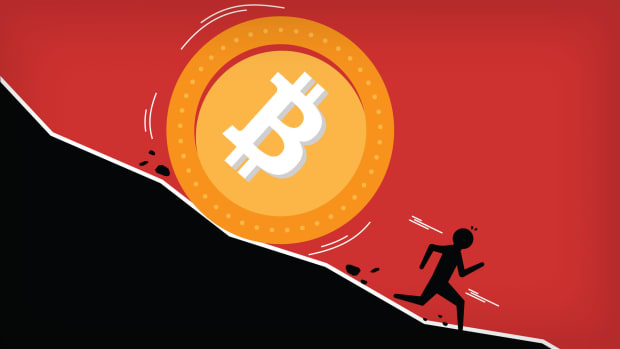For Gen Z, the crisis in the crypto industry, in which many of them have made and lost their first investments, is a very painful situation.
For millennials and older investors, the struggles in the crypto galaxy bring to mind the 2008 financial crisis.
The crypto-liquidity crisis started early May, when sister tokens Luna and UST collapsed, wiping out at least $55 billion of value and threatening the future of several eminent firms. It has been facilitated by a lack of rigorous risk management in this young and so far poorly regulated industry.
Rigorous risk management would have shown that one hedge fund, Three Arrows Capital, or 3AC, had borrowed money from different firms -- BlockFi, Voyager Digital, Babel Finance and others -- at the same time using the same bitcoin as collateral.
This feels like deja vu, say industry experts. There are similarities with the 2021 Archegos Capital Management scandal, but the analogy with the 2008 financial crisis also comes up.
TheStreet interviewed industry players about the current situation. Here's what they said.

Shutterstock
'Parallels' With the '08 Financial Crisis
"There are some parallels to the 2008 financial crisis," said Mark Fidelman, founder of SmartBlocks, the Miami marketing strategist for crypto.
"They both had a crisis derived from bad investment packages -- derivatives versus extreme leverage -- but in the 2008 crisis we had Wall Street committing fraud by labeling mortgage securities as AAA instead of junk.
"Where the 2022 crypto crisis started with someone exploring Luna’s algorithm. That created a domino effect on all the crypto funds relying on UST and on unrealistic gains."
Mike Boroughs, lead portfolio manager for Fortis Digital Asset Fund, says, "There's a lot of leverage or loans in the system, a lot of debt in the system that maybe shouldn't have been there."

Shutterstock
And Shane Molidor, chief executive of cryptocurrency financial platform AscendEX (formerly BitMax), says that "in 2007, it was the major investment banks that created complex derivatives like synthetic [collateralized debt obligations], which nobody, especially the government, really understood.
"When things started to unravel and mortgage owners began to default, the market was in the dark regarding the risk of systemic contagion.
"Unfortunately, we find ourselves in a similar situation right now in crypto. Many of the major lenders released little information about their lending activity, leaving the market grasping in the dark as participants try to 'price in' the risk of further contagion."
Retail Crypto Investors vs. CDO Investors
Molidor says that retail investors, who have often invested their savings in cryptocurrencies, risk experiencing the same fate as CDO investors.
"Just as many CDO investors were unaware of their exposure to subprime mortgage delinquencies, many retail customers who deposited funds into major crypto lenders never understood where the yield came from and were completely unaware that 3AC’s truly degen trading activity was, in part, funding their juicy APYs."
Michael Wilson, president and chief operating officer of green global exchange 1GCX., sums up: "The issues we’re seeing now in crypto have similarities in that the underlying sentiment of failure is panic on the out from the greed on the in."
Fidelman adds: "The actors in 2008 deliberately defrauded institutions and people. While in 2022, nefarious users exploited a flawed system. Very different in my opinion. Although in both scenarios the big institutions did not do their homework."

Getty Images
Transparency and Risk-Management Issues
Kenneth Goodwin, director of regulatory and institutional affairs at Blockchain Intelligence Group, says, "In both scenarios, the public (including consumer, retail, and institutional investors) was led by targeted marketing and communications to believe that these products (algorithm stablecoins and housing loans/[asset-backed securities]/[mortgage-backed securities]) offered higher yields."
Goodwin, who was working at the Federal Reserve Bank of New York during the 2008 financial crisis, adds that in both cases there's an "inability" to disclose market-driven risks. Crypto lenders Celsius and Babel Finance and hedge fund Three Arrows Capital are similar to Lehman Brothers, Bear Stearns, and many of the "Too Big to Fail Banks" as they all experienced higher leverage ratios than they reported, he argues.
"A common similarity in both scenarios is the inability to be transparent with their treasury management operations, trading positions, and ongoing surveillance of their portfolios," he says.

Getty Images
Differences Between 2008 and the Crypto Crisis
"The one difference, however, is that the crypto community is unregulated and, as such, does not have a liquidity backstop," says Goodwin.
"The contagion is much less widespread in the crypto market and is mostly caused by poorly managed risk by individual lenders/custodians," adds Wilson.

Shutterstock
Can the Crypto Crisis Spill Into the Real Economy?
"The exposure to failed crypto investors is further removed from Main Street than 2008," says Dan Hoover, director at Castle Funds, a firm that invests in bitcoin and other digital currencies.
"The 2008 crisis impacted major financial institutions such as Wells Fargo (WFC), Bank of America (BAC), and Citibank (C). These institutions were key liquidity providers to the 'everyday' economy, and their losses in mortgages cut back their ability to perform that critical function.
"Finally, regulators in the U.S. and elsewhere have increased capital requirements and reduced overall leverage by major market participants and systemically important institutions.
"This should mitigate the risk of another undercapitalized entity, such as AIG Financial Products (AIG), taking on an oversized role as counterparty to market participants and then failing."







